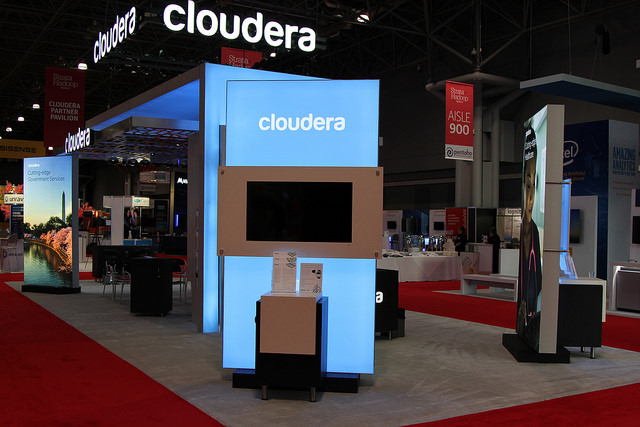Combined Cloudera And Hortonworks Plan To Take On Amazon

According to a Zion Market research report, the global hadoop market was estimated to grow at CAGR of 50% to $87.14 billion by the end of 2022. Billion Dollar Unicorn Cloudera (NYSE: CLDR) is a leading player in the segment which recently strengthened its standing in the market by announcing its merger with rival Hortonworks.
Cloudera’s Financials
Cloudera’s third quarter revenues grew 25% over the year to $118.18 million, ahead of the market’s forecast of $113 million. Net loss of $0.03 a share was also better than the Street’s estimates of a loss of $0.11 per share.
Subscriptions revenues grew 28% to $99.7 million and services revenues grew 12% to $18.5 million.
During the quarter, it added 33 customers with annual recurring revenue greater than $100,000, taking the count to 601.
For the current quarter, Cloudera forecast revenues of $119-$122 million with a net loss of $0.12-$0.10 per share. It expects to end the year with revenues of $450-$453 million and adjusted losses of $0.40-$0.38 per share. The market was looking for revenues of $119.7 million with a loss of $0.14 per share. They expect the company to end the year with revenues of $447.15 million and a loss of $0.51 per share.
Cloudera and Hortonworks Merger
Cloudera has been in the news recently for its $5.2 billion all-stock merger deal with Hortonworks. Santa Clara-based Hortonworks was spun out of Yahoo in 2011. It became a leading commercial vendor of Apache Hadoop. Its Data Platform is powered by Apache Hadoop and helps organizations build and deploy big data solutions on the open source platform. Essentially both Cloudera and Hortonworks use the same open-source code, but they operate in different but complementary markets. Hortonworks has grown through investments in the edge products while Cloudera has invested in the processing part of big data, including machine learning and artificial intelligence. They also support different cloud platforms. Cloudera supports Amazon Web Services and Microsoft Azure, while Hortonworks supports Google Cloud, IBM Cloud, and Azure.
Together, the companies plan to leverage their skills to offer an enterprise data cloud and an end-to-end platform that will include data ingestion, warehousing, advanced analytics, and AI across all private data centers and public cloud. Besides providing access to all the major cloud providers, the combined entity will also cover a wider variety of partnerships with data warehouses hardware makers, such as Oracle, Intel, IBM, and Teradata. The two companies plan to take on the might of Amazon through the merger as Amazon has been expanding into Cloudera’s world through investments in the database segment.
In its latest third quarter, Hortonworks reported revenues of $87.2 million, up 26%, a net loss of $31.6 million, and an adjusted loss of $0.06 per share. Fiscal 2017 revenue was $261.8 million and net loss was $204 million. The merger was completed earlier this year. Prior to the merger, Hortonworks had raised $248 million in venture funding and $100 million through its 2014 IPO at a valuation of $659 million.
Cloudera was founded in 2008 and went public in April 2017 when it raised $225 million by selling shares at $15 apiece at a valuation of $1.9 billion, a significant fall from its pre-IPO valuation. Prior to the listing, Cloudera had raised $1.04 billion in funding from investors including Intel Capital, Google Ventures, T. Rowe Price, Accel Partners, Ignition Partners, Greylock Partners, Meritech Capital Partners, In-Q-Tel, Caterina Fake, Youssri Helmy, Diane Greene, Qi Lu, and Jeff Weiner. Its last round of funding in March 2014 had valued it at $4.1 billion.
The open-source industry has seen much consolidation in the recent past. Last year, IBM acquired Red Hat for $34 billion and Microsoft acquired GitHub for $7.5 billion. Acquiring high-value companies may be the way to go for giants like Microsoft and Amazon. But does the same strategy work for the new Cloudera-Hortonworks combination?
The investors aren’t convinced. The new combined entity is called Cloudera and is currently trading at $13.19 with a market capitalization of $2 billion. It touched a 52-week high of $22.42 in March last year. It has recovered from the 52-week low of $10.07 in December last year. The stock had listed on the stock exchange in April 2017 at $15 with a valuation of $2.3 billion.
Amazon is a deadly competitor, and the prime concern Cloudera faces is how to combat the formidable giant. It’s a battle that would legitimately frighten investors.
Photo Credit: techmsg/Flickr.com
More investigation and analysis of Unicorn companies can be found in my latest Entrepreneur Journeys book, Billion Dollar ...
more


